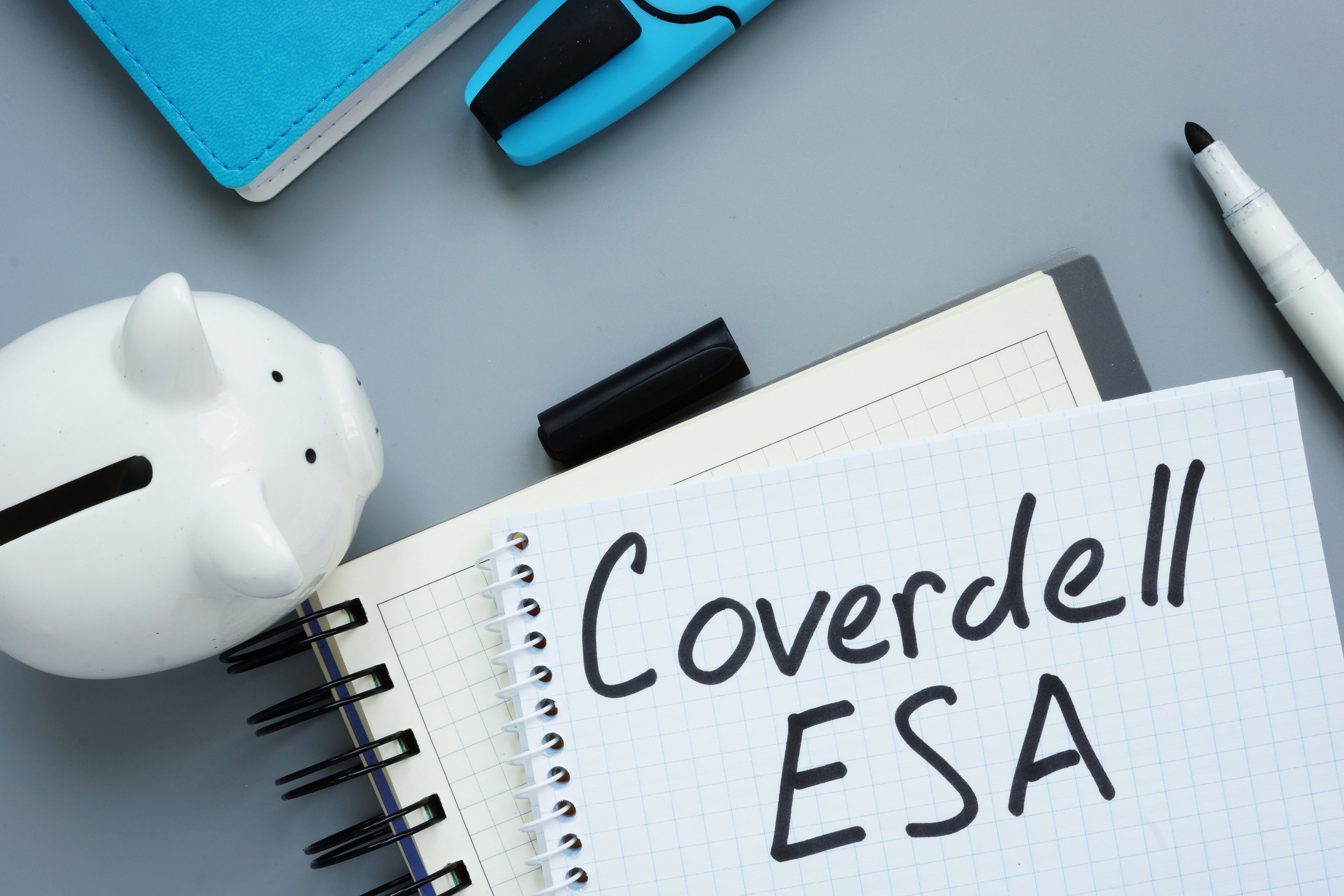Coverdell ESAs vs. 529 Plans: Which Should You Choose?
These savings accounts can offer tax benefits for school and retirement expenses. Here’s how.


Saving for your child or grandchild’s education is important, but it can be expensive. According to recent research by the Education Data Initiative, the average cost of a four-year college program has risen by 141% in the last 20 years.
And that’s not counting any K-12 expenses or tutoring help along the way.
Fortunately, two types of savings accounts may help fund a child’s education: 529 plans and Coverdell Education Savings Accounts (ESAs).
From just $107.88 $24.99 for Kiplinger Personal Finance
Become a smarter, better informed investor. Subscribe from just $107.88 $24.99, plus get up to 4 Special Issues

Sign up for Kiplinger’s Free Newsletters
Profit and prosper with the best of expert advice on investing, taxes, retirement, personal finance and more - straight to your e-mail.
Profit and prosper with the best of expert advice - straight to your e-mail.
These tax-advantaged savings methods are designed to help you contribute after-tax dollars for qualified tax-free withdrawals. Plus, you may even use some funds in a 529 plan for retirement.
Here are the ins and outs of 529 plans and Coverdell ESAs.
In the news: The so-called "Big Beautiful Bill" introduces several key changes to 529 plans and creates a new type of "kid savings account." For more information, check out Kiplinger's report, Money for Your Kids? Three Key Ways Trump's ‘Big Beautiful Bill’ Impacts Your Child's Finances.
Coverdell vs. 529 plan account
Before we dive into the differences between Coverdells and 529 plans, let’s run through a list of similarities. Both plans:
- Help you save for education expenses through a tax-advantaged savings account.
- Allow you to contribute after-tax dollars for qualified tax-free withdrawals (including any accrued interest).
- Impose a 10% penalty and may charge income tax if you use funds for non-qualified expenses (more on “qualified vs. non-qualified” expense types below).
- Can limit the beneficiary’s financial aid in college.
The last bullet is important if your child or beneficiary wishes to apply for student financial aid.
Having a 529 or Coverdell could reduce the amount received. While the impact on student aid is typically minimal, you may want to consult with a tax professional to get an accurate number on how your child’s student loan could be affected.
Next, we’ll cover the differences between Coverdells and 529 plans, starting with 529 withdrawals.
529 plan withdrawals for education: Qualified expenses
529 plans typically have a narrower range of so-called “qualified expenses.”
A qualified expense is anything that can be paid for by the plan that allows you to use the plan’s funds tax-free.
Until recently, 529s were used primarily for higher education. However, tax policy changes have allowed some K-12 expenses to count toward tax-free withdrawals.
As such, below is a list of 529 qualified expense examples (but keep in mind that state laws may vary):
- Higher education tuition (K-12 may be eligible, but only up to $10,000).
- Books, school fees, supplies, and equipment for higher education.
- College room and board (for students attending at least half-time, though on-campus vs. off-campus rules differ).
- Computers, software, and internet access for higher education.
- Certain special needs services and equipment (college or K-12).
- Costs for registered apprenticeship programs (generally not covered by Coverdells).*
- Up to $10,000 may be used to pay down student loans (typically not covered by Coverdells).*
*Except for those expenses noted, Coverdell ESAs usually allow most higher education costs to count as “qualified” expenses. Additionally, Coverdells have a wide variety of qualifying K-12 expenses. We’ll go over those next.
Coverdell ESA qualified expenses
Coverdells generally cover a much broader range of qualified expenses compared to 529 plans.
For instance, unlike a 529, a Coverdell ESA may be used for many K-12 expenses. Plus, Coverdells can be used for alternative learning experiences, like homeschooling. (However, under the new proposed tax bill, you might soon be able to use 529 plans for homeschooled children and other K-12 expenses.)
Here are more examples of Coverdell ESA qualified expenses:
- Academic tutoring for K-12 and higher education.
- K-12 and higher education computers, equipment, and internet access.
- College and K-12 books, school supplies, and fees.
- Elementary and secondary school uniforms and transportation costs.

Coverdell Education Spending Accounts have various age, income, and contribution limits for 2025 that may impact the allowable qualified expenses.
Coverdell ESA contribution and income limits
While Coverdells may allow a broader range of qualified educational expenses than 529 plans, these special savings accounts do come with a caveat: Annual contribution limits.
- The annual contribution limit per beneficiary is $2,000. This threshold applies to all Coverdells for that beneficiary.
- So, for example, if you have four contributors, each could only add a potential $500 total across all Coverdell ESAs for one beneficiary in a year (or risk a 6% excise tax, which applies to every year the extra contributions remain in the Coverdell account).
- Plus, the $2,000 contribution may be reduced, depending on a contributor’s modified adjusted gross income (MAGI).
- To contribute the full $2,000, the contributor’s MAGI must be less than $95,000 (single filers) or $190,000 (married filing joint couples).
- Once MAGI is above $110,000 (single) or $220,000 (married filing joint), then you cannot contribute to a Coverdell savings account.
Also, there are age limits that apply to Coverdells:
- Coverdell ESAs can only be contributed to until the beneficiary turns 18 (except for beneficiaries with special needs, then there are no contribution or withdrawal age limits).
- The funds must be utilized before the child reaches 30, or they could be subject to income taxes and a 10% penalty on the earnings portion.
Because of the Coverdell’s restrictive income limit, many families may be ineligible to use a Coverdell as a viable savings option.
Also, it’s important to note that, under a Coverdell ESA, the child (not the owner, like in the 529 plan) obtains control over the account once they turn 18 or 21 (depending on the state).
So if you’re looking to maintain control over the funds, Coverdells may not be the option for you and your family.
Who can contribute to a 529 plan?
While it’s possible to open a 529 plan through a private education organization, most 529 plans are state-sponsored. Fortunately, almost all states offer a 529 (Wyoming is the one exception).
But each state may have different rules and regulations governing the use of 529 savings accounts. You will need to check your state’s official 529 plan website or use the College Savings Plan Network search tool to find your state’s plan information.
The good news is that 529 plans do not have an annual contribution limit or income limit.
Although states typically enact a lifetime contribution threshold, the amount can be quite high, often several hundred thousand dollars.
But 529 plan contributions are subject to the federal gift tax exclusion, meaning you will need to report gift taxes if you contribute more than the 2025 amounts to a 529:
- Single filers up to $19,000.
- Married filing joint couples up to $38,000.
Yet more good news, though: 529 plans have no expiration, meaning that the funds remain no matter how old the child gets.
- This can be particularly useful if the beneficiary decides to attend school later in life, or for reusing the plan's funds for another beneficiary (more on that below).
- Having no age limit also means the 529’s owner will maintain control over the account (and not the child, as is the case with a Coverdell).
Coverdell ESA rollover to 529
Even with careful financial planning, you may not get around to spending every cent in a savings account by the time a child graduates. What then?
Well, whether you own a Coverdell ESA or a 529 plan, you may complete a rollover. This allows you to transfer funds from one account to another, even if the beneficiary is different.
For example, you can roll a Coverdell plan in the following ways:
- By rolling one beneficiary’s Coverdell into another beneficiary’s Coverdell (as long as both beneficiaries are in the same family and the new beneficiary is under 30).
- By rolling a Coverdell into a 529 plan (but only if both accounts have the same beneficiary).
You cannot roll funds from a 529 plan into a Coverdell ESA. However, you can roll a 529 plan in the following manner:
- By rolling over one child’s 529 plan into another child’s 529 plan, provided they’re in the same family.
- By rolling over funds from a 529 plan into a Roth IRA account for retirement savings (limits apply — see more details below).
Completing a rollover may extend your tax-free withdrawals while saving you from potentially paying penalties and taxes.
However, every rollover is subject to specific rules, so you’ll want to contact your plan administrator for the steps required and ask about any potential tax consequences that could result from an improper rollover.

529 plan contribution limits and qualified expenses can impact the number of qualified expenses you may claim with these tax-advantaged savings accounts.
529 rollover to Roth IRA
Thanks to the recently passed SECURE 2.0 Act, retirees can gain an added benefit from unused 529 funds: Retirement savings.
Not only can this help pay for a portion of your retirement, but rolling a 529 plan into a Roth account may also avoid taxable income and penalties associated with withdrawing funds for unqualified expenses.
However, there are specific rollover rules for converting a 529 plan to a Roth IRA:
- The 529 plan must have been open for at least 15 years.
- Plan contributions must have stopped at least five years ago.
- The beneficiary for both the 529 and the Roth must be the same, and the transfer must be direct: From one plan trustee to the other trustee.
- You may only roll over up to $35,000 of unused 529 funds into a Roth IRA (per beneficiary). This is a lifetime limit, meaning you’ll need to total all transfers if you have multiple 529s to roll over into Roth accounts.
- Additionally, these rollovers are subject to annual Roth IRA contribution limits.
Also, just because this rollover type is not federally taxed doesn’t mean you won’t pay state taxes. Your state may still consider this transaction a “non-qualified withdrawal” — so be sure to check your state’s 529 plan website or talk to your trusted tax advisor for details.
What is the best education savings account for kids?
Although there isn’t a “one size fits all” on whether you should start a 529 plan or a Coverdell ESA for your child (everyone’s financial situation is different), here are a handful of examples of when one account type might be more advantageous than the other:
- If you’re mostly saving for higher education expenses, like college or trade school, 529 plans potentially offer more savings and more time to spend them.
- However, if you want more control over investment options, you may choose a Coverdell ESA. 529s typically have pre-approved portfolios, while Coverdell ESAs allow you to use real estate, private equity, and sometimes cryptocurrencies to save for education.
- On the other hand, 529 plans don’t have income restrictions and offer larger contribution amounts. This can help if the beneficiary is attending a high-cost school. Additionally, some states offer a tax deduction or credit for 529 plan contributions, which can help offset higher contributions from a budgetary standpoint.
- Coverdells, meanwhile, allow you to save for K-12 tuition, tutoring, and even homeschooling. 529s offer comparatively few K-12 qualified expenses outside of tuition.
Of course, you could even use both plans simultaneously — a Coverdell for K-12, and a 529 plan for higher education purposes. But keep in mind that state tax rules may differ from federal guidelines, so be sure to consult with your tax professional to determine the best plan for your family’s future.
Read More
- New Roth 410(k) Changes You Should Know
- Homeschoolers: 529 Plan Savings Could Soon Work for You
- 12 Education Tax Credits and Deductions
- Here's How the Child Tax Credit Could Increase Under Trump
Profit and prosper with the best of Kiplinger's advice on investing, taxes, retirement, personal finance and much more. Delivered daily. Enter your email in the box and click Sign Me Up.

Kate is a CPA with experience in audit and technology. As a Tax Writer at Kiplinger, Kate believes that tax and finance news should meet people where they are today, across cultural, educational, and disciplinary backgrounds.
-
 I'm want to give my 3 grandkids $5K each for Christmas.
I'm want to give my 3 grandkids $5K each for Christmas.You're comfortably retired and want to give your grandkids a big Christmas check, but their parents are worried they might spend it all. We ask the pros for help.
-
 If You're Not Doing Roth Conversions, You Need to Read This
If You're Not Doing Roth Conversions, You Need to Read ThisRoth conversions and other Roth strategies can be complex, but don't dismiss these tax planning tools outright. They could really work for you and your heirs.
-
 Could Traditional Retirement Expectations Be Killing Us?
Could Traditional Retirement Expectations Be Killing Us?A retirement psychologist makes the case: A fulfilling retirement begins with a blueprint for living, rather than simply the accumulation of a large nest egg.
-
 5 Types of Gifts the IRS Won’t Tax: Even If They’re Big
5 Types of Gifts the IRS Won’t Tax: Even If They’re BigGift Tax Several categories of gifts don’t count toward annual gift tax limits. Here's what you need to know.
-
 The 'Scrooge' Strategy: How to Turn Your Old Junk Into a Tax Deduction
The 'Scrooge' Strategy: How to Turn Your Old Junk Into a Tax DeductionTax Deductions We break down the IRS rules for non-cash charitable contributions. Plus, here's a handy checklist before you donate to charity this year.
-
 IRS Says You Made a Tax Return Mistake? A New Law Could Help You Fight Back
IRS Says You Made a Tax Return Mistake? A New Law Could Help You Fight BackTax Law Updated taxpayer protections change what the IRS must explain on error notices and how long you have to respond.
-
 Is a New $25,000 Health Care Tax Deduction Coming in 2026?
Is a New $25,000 Health Care Tax Deduction Coming in 2026?Tax Policy A proposal from GOP Sen. Josh Hawley adds to the chatter about health care affordability.
-
 Are You Middle-Class? Here's the Most Tax-Friendly State for Your Family
Are You Middle-Class? Here's the Most Tax-Friendly State for Your FamilyTax Tips We found the state with no income tax, low property tax bills and exemptions on groceries and medicine.
-
 Costco Sues Over Trump Tariffs: What Could That Mean for Prices in 2026?
Costco Sues Over Trump Tariffs: What Could That Mean for Prices in 2026?Tariffs The retailer is making headlines not just for its famous hot dog and gold bars but for suing the Trump administration over tariffs.
-
 Social Security Benefits Quiz : Do You Know the IRS Tax Rules?
Social Security Benefits Quiz : Do You Know the IRS Tax Rules?Quiz Social Security benefits often come with confusing IRS tax rules that can trip up financially savvy retirees and near-retirees.
-
 How Are I Bonds Taxed? 8 Common Situations to Know
How Are I Bonds Taxed? 8 Common Situations to KnowBonds Series I U.S. savings bonds are a popular investment, but the federal income tax consequences are anything but straightforward.